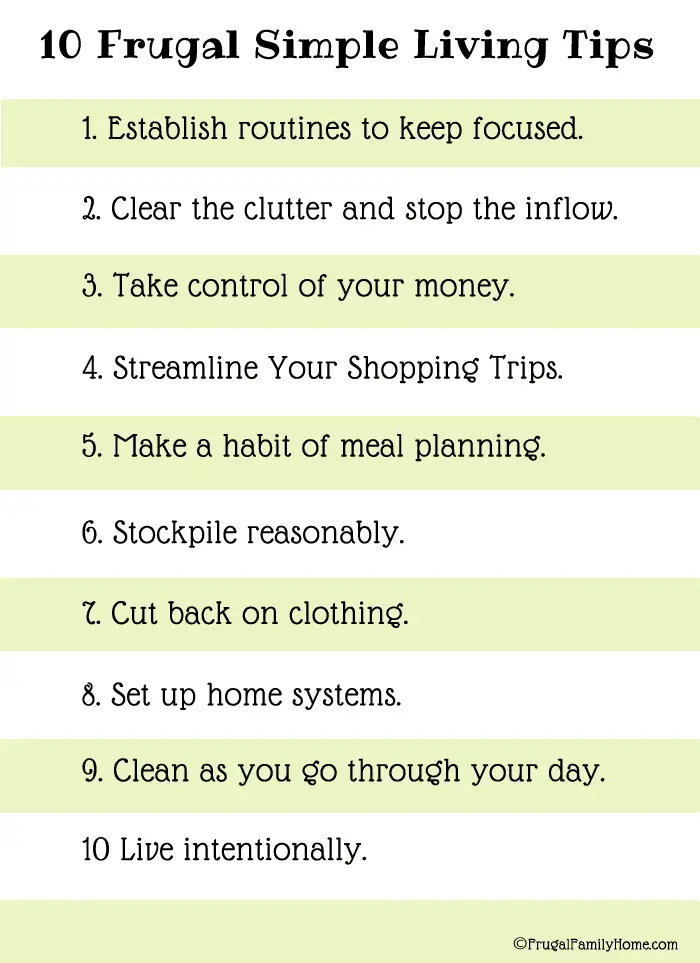Looking to save some cash? Look no further! In this article, we’ll explore 9 frugal living tips that can help you save money and prioritize what matters to you. From prepping and cleaning your kitchen to exploring stores for deals, these routines are designed to keep you on track and save you some extra cash. We’ll even include a helpful quote from Octavia Butler on the importance of habits in saving money and living frugally. So, grab a pen and paper and get ready to set up your money-saving frugal living routine today!
Are you feeling the need to tighten your budget? Don’t worry, we’ve got you covered! Get ready to discover 9 frugal living tips that can help you save money and live more financially responsibly. From prepping and cleaning your kitchen to exploring the outdoors and cooking your favorite breakfast, these frugal living routines will keep you on track and help you cut costs. So, let’s dive in and start saving money today!
Prepping and Cleaning Your Kitchen
Keeping your kitchen clean and organized is essential not only for maintaining a healthy living space but also for creating a budget-friendly lifestyle. By following some simple tips and tricks, you can ensure that your meal planning and prepping are done efficiently, your kitchen is well-organized, and you can even make your own cleaning products to save money.
1.1. Meal planning and prepping
Meal planning and prepping is the foundation of a frugal and efficient kitchen. By taking the time to plan your meals ahead of time, you can avoid unnecessary trips to the store and reduce food waste. Start by creating a weekly or monthly meal plan, taking into consideration your budget, dietary preferences, and the ingredients you already have on hand. This will help you avoid impulse purchases and ensure that you use up any perishable items before they go bad.
Once you have your meal plan in place, it’s time to start prepping. Dedicate a specific time each week to prepare ingredients and meals in advance. This could involve chopping vegetables, marinating meat, or even cooking and portioning out meals for the week. By doing this, you’ll save time during the busy weekdays and be less tempted to order takeout or dine out, ultimately saving money.
1.2. Efficiently organizing your kitchen
An organized kitchen not only makes cooking and meal prepping easier but also helps you save money by reducing the chances of ingredients going bad or getting lost in the clutter. Start by decluttering your kitchen and getting rid of any unnecessary items. Sort through your cabinets and pantry, throwing away expired products and donating items you no longer use.
Next, invest in some affordable storage solutions to maximize your space. Use clear containers or mason jars to store bulk items like rice, pasta, and spices. This not only keeps your pantry organized but also makes it easier to see what you have on hand, preventing unnecessary duplicate purchases.
Consider organizing your kitchen based on categories like baking ingredients, canned goods, and snacks. This way, you’ll have a clear idea of what you need to restock and avoid overbuying. Don’t forget to label your containers for easy identification.
1.3. Making your own cleaning products
Cleaning products can be expensive, and many of them are filled with harsh chemicals that can be harmful to your health and the environment. Instead, consider making your own cleaning products using simple ingredients you probably already have at home. Not only will this save you money, but it will also give you peace of mind knowing exactly what is in the products you’re using.
For an all-purpose cleaner, mix equal parts white vinegar and water in a spray bottle. This can be used to clean countertops, sinks, and even floors. For tough grease and grime, adding a few drops of dish soap to the mixture can be highly effective. Baking soda is another great natural cleaning agent that can be used for scrubbing surfaces and removing odors.
Making your own cleaning products is not only cost-effective but also a fun and sustainable way to take care of your kitchen. You can even personalize them by adding essential oils for a pleasant scent. Experiment with different recipes and find what works best for you.
Exploring Stores for Deals
Finding great deals and discounts is key to maintaining a frugal lifestyle. Luckily, there are many strategies you can use to save money while shopping, including utilizing coupons and loyalty programs, shopping discounted items and sales, and buying in bulk.

2.1. Utilizing coupons and loyalty programs
Coupons and loyalty programs are excellent ways to save money while shopping. Start by collecting coupons from your local newspapers, magazines, or online coupon websites. Some stores may offer their own coupons or have digital coupons that can be loaded onto your loyalty card. Take advantage of these savings by planning your shopping trips around the items that have coupons available.
Signing up for loyalty programs at your favorite stores can also lead to significant savings. These programs often offer exclusive discounts, reward points, and personalized offers. Keep track of your favorite stores’ sales cycles and maximize your savings by combining coupons with discounted items.
2.2. Shopping discounted items and sales
Another great way to save money on your everyday purchases is by shopping for discounted items and sales. Many stores have clearance sections where you can find discounted products that are still of good quality. Keep an eye out for seasonal sales, holiday promotions, and end-of-season clearance events. By shopping strategically, you can save a significant amount of money on clothing, household items, and even groceries.
Additionally, consider purchasing non-perishable items in bulk when they are on sale. This is especially beneficial for items with a long shelf life, such as toiletries, cleaning supplies, and pantry staples. Buying in bulk not only saves you money in the long run but also reduces the frequency of shopping trips, saving you time and transportation costs.
2.3. Buying in bulk
Buying in bulk is a popular strategy for saving money and can be particularly effective for staple items that you use frequently. Look for wholesale or bulk stores in your area, as they often offer a wide range of products at discounted prices. Buying in bulk is especially advantageous for items like rice, pasta, canned goods, and cleaning supplies.
To make the most of your bulk purchases, be mindful of the expiration dates and storage requirements of the items. Make sure you have enough space to store your bulk purchases properly, as some items may require airtight containers or refrigeration. By planning ahead and purchasing in bulk, you can save money and reduce the number of trips you need to make to the store.
Doing Your Job
With the cost of living constantly on the rise, it’s essential to maximize your productivity and efficiency at work to secure financial stability. By focusing on strategies such as maximizing productivity, negotiating for promotions and raises, and utilizing work benefits and perks, you can enhance your career and increase your income.

3.1. Maximizing productivity and efficiency
One of the most important aspects of excelling at your job is maximizing your productivity and efficiency. Start by setting clear goals and priorities for each day or week. Break down larger tasks into smaller, manageable steps, and create a schedule or to-do list to stay organized.
Eliminate distractions by creating a designated work area and minimizing interruptions. Consider turning off notifications on your phone or using website-blocking apps to avoid temptation. Additionally, take regular breaks to recharge and maintain focus throughout the day.
Time management is also crucial for productivity. Explore techniques such as the Pomodoro Technique, which involves working in focused bursts followed by short breaks. This can help you stay motivated and avoid burnout.
3.2. Negotiating for promotions and raises
Negotiating for promotions and raises is an important step in advancing your career and increasing your income. Start by doing thorough research on the market value of your role and the salary range for similar positions in your industry. This will give you a solid understanding of your worth and help you make a persuasive case for a raise or promotion.
When negotiating, focus on highlighting your achievements, contributions, and any additional responsibilities you have taken on. Clearly demonstrate how these efforts have positively impacted the company or team. Prepare a compelling argument and be confident in your abilities and the value you bring to the organization.
Additionally, consider seeking out opportunities to expand your skills and knowledge. Take advantage of training programs offered by your employer or invest in professional development courses that can enhance your expertise. By continuously improving yourself, you increase your value and leverage when negotiating for promotions and raises.
3.3. Utilizing work benefits and perks
Many employers offer a range of benefits and perks that can help improve your financial situation. Take full advantage of these offerings to save money and enhance your overall well-being. Common workplace benefits include retirement plans, healthcare benefits, paid time off, and flexible work arrangements.
Take the time to understand the details of your benefits package and how you can make the most of them. Are there opportunities to contribute to a retirement plan with employer matching? Can you take advantage of healthcare savings accounts or wellness programs offered by your employer? These benefits can provide significant savings on healthcare expenses.
Additionally, explore any employee discounts or perks that your company may offer. This could include discounts on gym memberships, public transportation passes, or even discounted tickets for entertainment and events. By utilizing these perks, you can enjoy a higher quality of life while saving money.
Exploring the Outdoors
Finding low-cost or free ways to enjoy the outdoors is not only a great way to have fun but also to save money. By engaging in free or low-cost outdoor activities, utilizing public parks and recreational areas, and participating in community events and programs, you can stay active and connect with nature without breaking the bank.

4.1. Engaging in free or low-cost outdoor activities
When it comes to outdoor activities, there are plenty of options that won’t cost you a fortune. Consider activities such as hiking, biking, or walking in local parks or nature reserves. These activities not only provide exercise but also allow you to enjoy the beauty of nature at no cost.
If you enjoy water activities, look for nearby lakes or rivers where you can swim, kayak, or paddleboard. Many areas have public beaches or swimming pools that offer affordable entry fees. You can also explore fishing, which is both relaxing and rewarding.
Another low-cost outdoor activity is birdwatching. Grab a pair of binoculars and a field guide and head to a local wildlife refuge or bird sanctuary. You’ll be amazed at the variety of birds you can spot and the peace that comes with observing these beautiful creatures in their natural habitat.
4.2. Utilizing public parks and recreational areas
Public parks and recreational areas are excellent resources for enjoying the outdoors without spending a fortune. Many cities and towns have parks that offer free access to amenities such as hiking trails, picnic areas, and playgrounds. Take advantage of these spaces by organizing a picnic with friends or family, going for a bike ride, or simply enjoying a leisurely walk.
In addition to parks, look for recreational areas that offer affordable access to facilities like tennis courts, basketball courts, or swimming pools. Some communities may even have free or low-cost fitness classes or sports leagues that you can join. These activities not only keep you active but also provide opportunities to meet new people and foster a sense of community.
4.3. Participating in community events and programs
Community events and programs are great ways to engage with your local community while enjoying low-cost or free activities. Many towns and cities organize festivals, fairs, and farmer’s markets that offer free entry and entertainment. These events provide a fun and affordable way to explore local culture, try new foods, and enjoy live performances.
Check your local library or community center for free or inexpensive workshops, classes, and seminars. These venues often host events on a variety of topics, ranging from cooking or gardening workshops to financial management or arts and crafts classes. Participating in these programs not only expands your knowledge and skills but also provides opportunities for socializing with like-minded individuals.
By actively participating in community events and programs, you can support local businesses and organizations while enjoying budget-friendly activities. It’s a win-win for both your wallet and your community.
Cooking Your Favorite Breakfast
A budget-friendly breakfast routine is essential to saving money and starting your day off right. By creating a budget-friendly breakfast routine, trying homemade breakfast recipes, and utilizing affordable ingredients and leftovers, you can enjoy delicious and nutritious meals without breaking the bank.

5.1. Creating a budget-friendly breakfast routine
Creating a budget-friendly breakfast routine starts with planning. Take the time to calculate your breakfast expenses and determine how much you’re willing to spend each week. This will help you establish boundaries and make conscious choices about your breakfast meals.
Invest in staples that are both affordable and versatile. Items like oats, eggs, bread, and seasonal fruits are budget-friendly options that can be used in a variety of breakfast recipes. Consider purchasing these items in bulk to save even more money.
Meal prepping breakfast can also save you time and money. Prepare overnight oats or egg muffins in advance and store them in the fridge or freezer. This way, you can simply grab a pre-made breakfast option in the morning, eliminating the need for expensive and unhealthy on-the-go breakfast choices.
5.2. Trying homemade breakfast recipes
Trying homemade breakfast recipes is not only more cost-effective than dining out but also allows you to control the ingredients and portions. Explore simple recipes like scrambled eggs with veggies, homemade granola with yogurt, or avocado toast. These dishes are easy to prepare, require minimal ingredients, and are much healthier than many store-bought alternatives.
Experiment with different flavors and ingredients to keep your breakfast routine interesting. Consider incorporating seasonal produce or trying new spices and herbs to add variety to your meals. Not only will this save you money, but it will also introduce you to new and exciting flavor combinations.
5.3. Utilizing affordable ingredients and leftovers
Utilizing affordable ingredients and leftovers is a great way to stretch your breakfast budget. Don’t be afraid to get creative with what you have on hand. Leftover vegetables from dinner can be sautéed and added to an omelet or scrambled eggs. Stale bread can be transformed into French toast or used to make a delicious breakfast strata.
Consider purchasing frozen fruits, which are often more affordable than fresh ones and can be used in smoothies, oatmeal, or yogurt bowls. Alternatively, buy fresh fruits in bulk when they are in season and freeze them yourself for later use.
By utilizing affordable ingredients and leftovers, you can create delicious and satisfying breakfast meals without spending a fortune. Get creative in the kitchen and have fun experimenting with new recipes and flavors.
Doing Your Hair
Maintaining a well-groomed appearance doesn’t have to come with a hefty price tag. By researching and practicing DIY hair care, trying simple and affordable hairstyles, and using cost-effective hair products, you can achieve salon-worthy results while saving money.

6.1. Researching and practicing DIY hair care
Researching and practicing DIY hair care is a great way to improve the health and appearance of your hair without spending money on professional treatments. Start by understanding your hair type and specific needs. This will help you choose the right products and techniques for your hair.
Experiment with homemade hair masks made from ingredients like coconut oil, avocado, or honey. These natural ingredients can help moisturize, nourish, and repair your hair. Look for DIY recipes online or in hair care books and test them out to find the ones that work best for you.
Regularly deep condition your hair to keep it healthy and prevent breakage. Deep conditioning treatments can be done at home by applying a moisturizing mask or oil to your hair, covering it with a shower cap, and leaving it on for at least 30 minutes. This allows the ingredients to penetrate the hair shaft and provide maximum hydration.
6.2. Trying simple and affordable hairstyles
Trying simple and affordable hairstyles is a great way to change up your look without spending money at a salon. Start by mastering basic hairstyles like braids, buns, or ponytails. These styles are versatile, easy to create, and require minimal products and tools.
Experiment with different hair accessories to add flair to your hairstyles. Headbands, hair clips, and scrunchies can instantly elevate a simple hairstyle and give it a trendy or elegant touch.
For special occasions or when you want to achieve a more polished look, consider learning basic styling techniques like blowouts or curling with hot rollers or a straightener. There are plenty of online tutorials and resources available that can help you learn these skills at no cost.
6.3. Using cost-effective hair products
Using cost-effective hair products is essential for maintaining a frugal lifestyle. Start by understanding your hair’s needs and choosing products that address them without breaking the bank. Look for affordable shampoos and conditioners that are free of harsh chemicals and sulfates.
Consider purchasing multi-purpose products that can serve multiple functions. For example, a leave-in conditioner can also be used as a styling cream, reducing the number of products you need to buy. Similarly, a dry shampoo can help extend the time between washes, saving you both time and money.
Don’t be afraid to explore store brands or generic versions of popular hair care products. Many of these options offer the same quality as their more expensive counterparts, but at a fraction of the price. Read reviews and ask for recommendations to find affordable hair products that work well for you.
Eating Prepped Food
Meal prepping is not only a time and sanity saver but also a cost-effective way to ensure you have delicious and nutritious meals ready to go. By meal prepping for cost and time efficiency, utilizing leftovers and repurposing ingredients, and packing homemade meals for work or outings, you can save money on dining out and reduce food waste.
7.1. Meal prepping for cost and time efficiency
Meal prepping involves preparing meals and ingredients in advance to save time and effort throughout the week. Not only does this help you stay on budget, but it also ensures that you have healthy and satisfying meals ready when hunger strikes.
Choose recipes that are budget-friendly and can be easily portioned and stored. Casseroles, stir-fries, and one-pot meals are excellent candidates for meal prepping. Cook large batches of these dishes and portion them into individual containers for easy grab-and-go meals.
In addition to main dishes, meal prepping snacks and breakfast items can also save you money and reduce your reliance on store-bought convenience foods. Consider making your own granola bars, energy balls, or muffins, and portion them out for the week ahead. This way, you’ll have nutritious and cost-effective snacks readily available.
7.2. Utilizing leftovers and repurposing ingredients
Utilizing leftovers and repurposing ingredients is a useful strategy for minimizing food waste and maximizing your grocery budget. Get creative with what you have on hand and transform leftover ingredients into new and exciting dishes.
For example, leftover grilled chicken can be shredded and used in sandwiches, salads, or wraps. Day-old rice can become the base for a delicious stir-fry or fried rice. Overripe bananas can be turned into moist and delicious banana bread.
When planning your meals, consider ingredients that can be used in multiple dishes throughout the week. For example, cook a large batch of quinoa that can be used as a side dish one night and in a salad the next. By utilizing leftovers and repurposing ingredients, you’ll save money and reduce food waste, all while enjoying a varied and delicious menu.
7.3. Packing homemade meals for work or outings
Packing homemade meals for work or outings is an excellent way to save money on dining out and ensure that you’re nourished throughout the day. Invest in reusable containers and lunch bags to safely transport your meals.
When meal prepping, dedicate a portion of your cooking time to prepare lunches for the week ahead. Salads, wraps, and grain bowls are nutritious and customizable options that can be easily packed. Don’t forget to include fruits, vegetables, and healthy snacks like nuts or yogurt to round out your meal.
Packing homemade meals not only saves you money but also allows you to have greater control over the ingredients and portion sizes. By making conscious choices about what you eat, you can maintain a healthy lifestyle while sticking to your budget.
Doing Your Job Again
Continuing to excel at your job is essential for long-term financial stability. By taking on extra projects or freelance work, building additional skills for career advancement, and seeking out opportunities for increased income, you can further enhance your financial situation and open new doors for professional growth.
8.1. Taking on extra projects or freelance work
Taking on extra projects or freelance work can be a great way to boost your income and gain valuable experience. Start by exploring opportunities within your current workplace. Look for projects or tasks that align with your skills and interests and offer the potential for additional compensation.
If your current job doesn’t offer such opportunities, consider freelancing in your spare time. Many industries have a demand for freelance work, ranging from writing and graphic design to web development and consulting. Leverage your skills and expertise to secure freelance contracts that can supplement your income.
It’s important to strike a balance between your full-time job and freelancing commitments to avoid burnout. Plan your time wisely and communicate your availability and workload with both your employer and freelance clients.
8.2. Building additional skills for career advancement
Building additional skills is crucial for career advancement and increasing your earning potential. Take advantage of any training or professional development programs offered by your employer. These opportunities can provide you with new skills, knowledge, and certifications that can set you apart from your peers.
Consider taking online courses or attending workshops in your field of interest. There are many affordable or free resources available that can help you learn new skills or deepen your expertise. Stay updated with industry trends and follow thought leaders to identify emerging skills that are in high demand.
Building a diverse skillset not only makes you more marketable but also provides opportunities for career growth within your current organization. By continuously learning and expanding your knowledge, you increase your chances of promotion and higher income.
8.3. Seeking out opportunities for increased income
Seeking out opportunities for increased income is essential for long-term financial stability. Requesting a raise or promotion within your current organization is one way to achieve this. Schedule a meeting with your supervisor to discuss your accomplishments, contributions, and the value you bring to the company. Make a compelling case for why you deserve a salary increase or a higher position.
In addition to exploring opportunities within your current workplace, keep an eye out for job openings in your industry that offer better compensation or career growth potential. Network with professionals in your field, attend industry events, and leverage online platforms to stay connected and aware of job opportunities.
Consider diversifying your income streams by investing in stocks, real estate, or other ventures. These investments can provide passive income and increase your overall financial security. However, always conduct thorough research and seek professional advice before venturing into new investment opportunities.
Walking to the Store
Opting for walking or biking for local errands is not only a great way to save money but also prioritize your health and the environment. By choosing to walk instead of drive for short trips, saving transportation costs, and making exercise a part of your daily routine, you can live a frugal and healthier lifestyle.
9.1. Opting for walking or biking for local errands
Walking or biking for local errands is an excellent way to save money on transportation costs and reduce your carbon footprint. Instead of automatically reaching for your car keys, consider the distance and weather conditions before deciding on a mode of transportation.
For short trips to the grocery store, pharmacy, or nearby coffee shop, opt for walking whenever possible. Not only will you save money on gas and parking fees, but you’ll also get some exercise and fresh air. Biking is another great option for slightly longer distances. Invest in a reliable bike and accessories like a helmet, lock, and bike lights for safety.
9.2. Saving transportation costs
Saving transportation costs is a key aspect of frugal living. One of the most effective ways to do this is by reducing your reliance on personal vehicles. Evaluate your transportation needs and identify opportunities to carpool, use public transportation, or bike or walk instead.
Explore public transportation options in your area. Buses, trams, or trains can be cost-effective alternatives to driving, particularly if you’re traveling longer distances or in congested areas. Many cities offer discounted public transportation passes or fare cards, which can provide significant savings over time. Additionally, public transportation allows you to relax or catch up on work during your commute, making better use of your time.
Not only do you save on fuel costs by reducing the use of your car, but you also reduce the wear and tear on your vehicle. This can result in fewer maintenance expenses and a longer lifespan for your vehicle. By using alternative modes of transportation, you can save money and contribute to a more sustainable future.
9.3. Prioritizing health and exercise
Choosing to walk or bike instead of driving not only saves money but also prioritizes your health and well-being. Walking is a low-impact exercise that can be easily incorporated into your daily routine. It improves cardiovascular health, strengthens muscles and bones, and boosts mood and mental well-being.
Regular exercise has been linked to a reduction in healthcare costs and can contribute to long-term financial stability. By prioritizing exercise through walking or biking, you can save money on gym memberships or fitness classes. Furthermore, the increased physical activity can potentially decrease healthcare expenses by reducing the risk of chronic diseases.
Make walking or biking a part of your daily routine by setting aside time in the mornings or evenings for a walk or bike ride. If your workplace is within walking or biking distance, consider commuting by foot or bicycle. Not only will this save you money on transportation, but it will also kickstart your day with a burst of exercise and fresh air.
Conclusion
Having a frugal living routine is essential for saving money and achieving financial stability. By following the strategies outlined in this article, such as prepping and cleaning your kitchen, exploring stores for deals, maximizing productivity and efficiency at work, exploring the outdoors, cooking budget-friendly meals, doing your hair at home, eating prepped food, taking on extra projects or freelance work, walking or biking for local errands, and prioritizing your health, you can maintain a balanced and cost-effective lifestyle.
Remember, frugality doesn’t mean sacrificing quality or enjoyment. It’s about making conscious choices, being resourceful, and focusing on the things that truly matter to you. By implementing these habits and techniques into your daily life, you’ll be well on your way to achieving financial freedom and living your best life. As Octavia Butler once said, “Habit is more dependable than inspiration.” So, start cultivating these frugal habits today and embrace the rewards they will bring in the long run.


